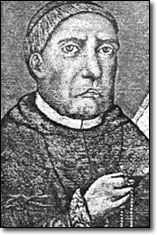1.2 History as a literary genre, Pedro Agustín Morell de Santa Cruz, antecedents dating back to 1703

The first textual antecedents that reflect the intention of collecting the line of the past events of the Island date back to the 18th century, the previous ones constituting a gap in that sense, since no work conceived during the course of those centuries has survived, even though it is not possible to presume that there were no attempts in the matter.
The first literary figure to take an interest in describing the past was the priest Onofre de Fonseca (1648–1710), author of “History of the Miraculous Apparition of Our Lady of Charity of El Cobre,” in 1703. This work is not considered a precursor to historical and literary writing because of its religious and popular roots, nor because of its treatment as an incontrovertible fact; rather, it is due to the use of sources as evidence and the implicit desire to rescue the past and give substance to tradition.
Later bibliographies reflect the existence of texts that were never found, with only records of their titles and, in some cases, authors. Among these is “Letter and Account of the Island of Cuba and its Particularities, with Three Histories of the Governors of Havana from 1549 to 1725, of the Bishops until 1705, and of the Viceroys of Mexico,” by Ambrosio de Zayas Bazán (1666–1748). This was the case with other works. It is worth mentioning the lost texts of “History of the Literary University of San Gerónimo on the Island of Cuba,” by priest José Manuel Mayorga, and “News of the Writers of the Island of Cuba,” whose titles are suggestive for reconstructing the literary panorama of the period.
The figure of Bishop Pedro Agustín Morell de Santa Cruz (1694 – 1768) stands out in the dawn of historiography, to which he left some significant contributions. His most important work, with the consensus of many specialists, is “Apostolic, topographical, historical and statistical visit of all the towns of Nicaragua and Costa Rica”, from 1751. In 1746 he had written “Relationship of the attempts of Englishmen in America” and in 1749, “Historical account of the primitive bishops and governors of Cuba”, which implies a relatively broad spectrum of topics.
As part of his episcopal duties, he also wrote texts that bear witness to events and situations that reflect the stark life of the colony. The “Pastoral Letter of the Most Illustrious Bishop of Cuba to his Diocese on the Occasion of the Earthquake in the City of Santiago and Adjacent Places,” from 1766, contains revealing paragraphs:
“The powerful suck the blood of the poor, grow fat with the sweat of their brow, grow strong with their wages, fail to honor contracts, overstay their deadlines, enforce excessive usury, and do nothing to quench their infamous thirst for gold, and they achieve it all with impunity by maintaining lifelong lawsuits, from which their grandchildren have no way of surviving. The poor, harassed by such tyrannies, give themselves over to idleness, and do not work, except to overcome their needs with theft, robbery, criminal contemplations and false oaths.”
The works generally lack the analytical function essential to historical accuracy, and are loaded with details that reveal the author’s difficulty in distinguishing between the main and secondary aspects of his description of events. The style is also lacking in refinement, but the aim of clearly presenting the events is evident. However, the simple desire to chronicle the island’s future, sometimes with a perspective closer to a chronicle, places him among the pioneers of the genre in the island context.








